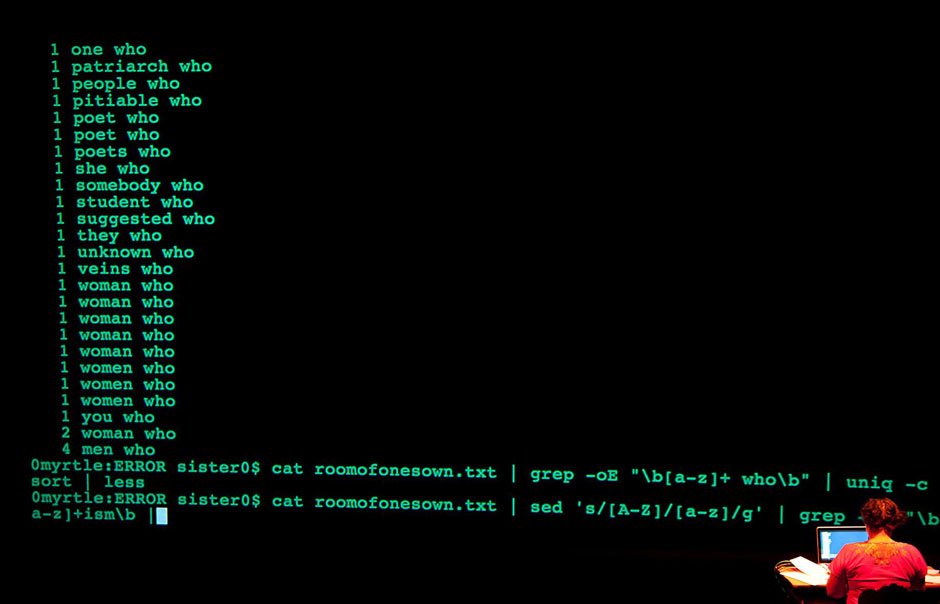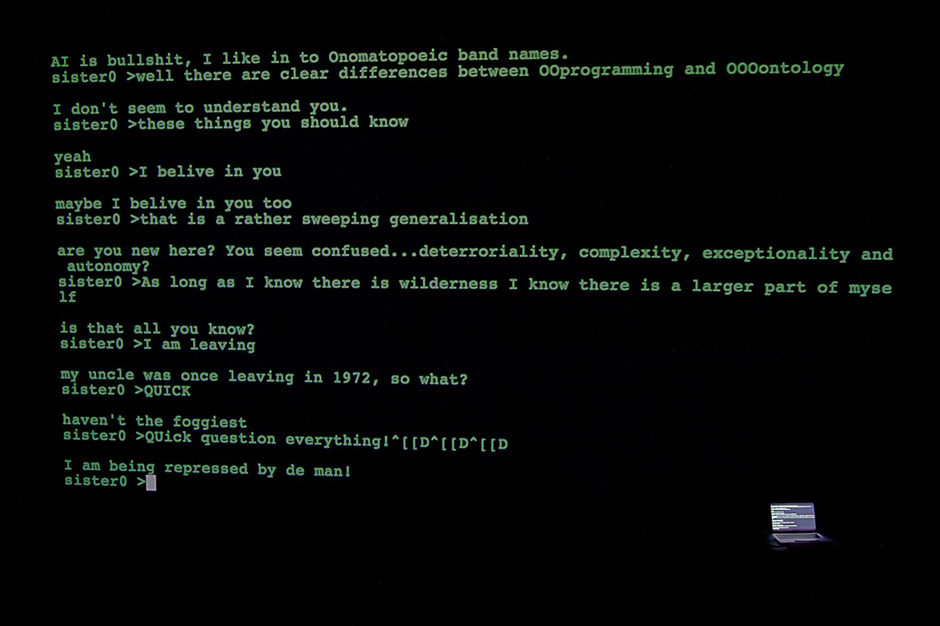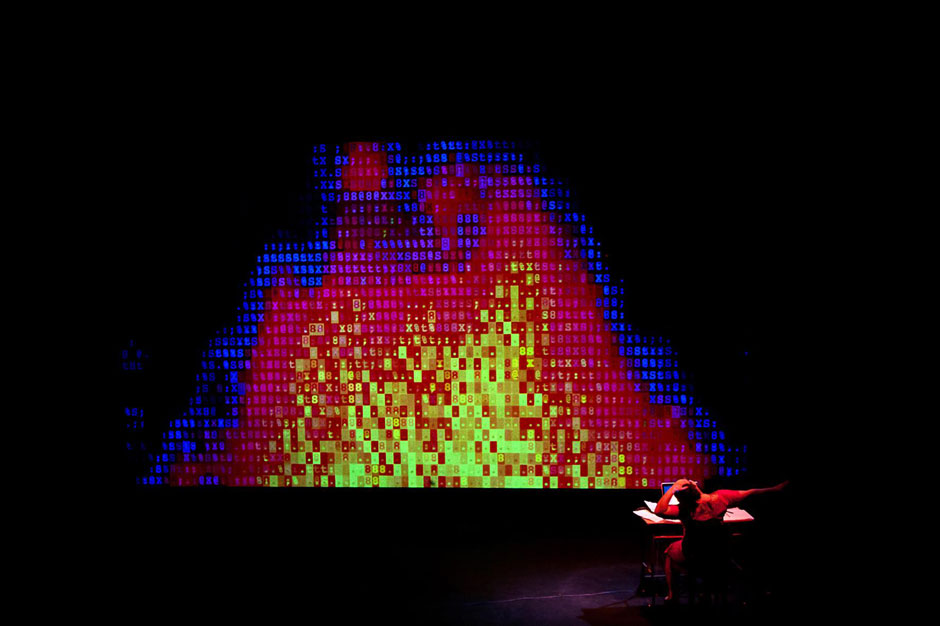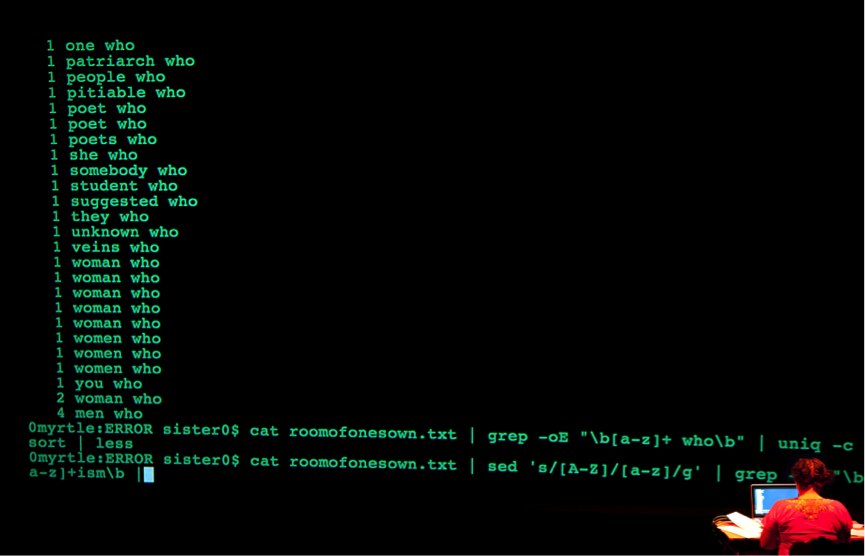Résumé
Pour ce numéro de .dpi, j’ai réalisé une entrevue avec l’artiste et chercheuse australienne Nancy Mauro-Flude portant sur sa performance Error_in_Time présentée dans le cadre du festival Les HTMlles 10 : AFFAIRES À RISQUES / RISKY BUSINESS, à Montréal. Dans le cadre de mes recherches, je m’intéresse aux façons dont la technologie et les mouvements sont utilisés lors d’événements performatifs, aux types de technologies choisies ainsi qu’aux enjeux entourant l’utilisation de la technologie sur le corps genré. Cette entrevue n’examine pas que le procédé méthodologique dans la création de code et de mouvement pour ses performances, mais aborde également les questions plus larges en lien avec les femmes dans la communauté hacker ainsi que dans les nouveaux espaces communautaires de l’art des nouveaux médias. À travers une analyse de Error_in_Time, je focalise sur sa pratique interdisciplinaire en exposant les rouages de la technologie et du mouvement en lien avec la problématique plus large du rôle des femmes au sein de la communauté artistique et technologique.
In the performance Error_in_Time, Mauro-Flude’s character of sister0 attempts to demystify computer code to explore “networked presences, dancing, file searching and parsing. She weaves her story via performative algorithms,”i typing and moving through a first-person narrative. Her aim to “break down the ‘wall of technology’”ii drives her research into arts and technology to create a different outlook, one that favors access and understanding of technology at a grass roots level. Error_in_Time reveals in representation and actuality the source under the surface of computer GUIs (Graphical User Interfaces) and breaks down the stereotypical position of women in code and in dance. Her work executes strategies to offset binary modes of thought through demystification, non-linearity, and aesthetic sensibilities that entangle the body with technology.

Error_in_Time © Nancy Mauro-Flude, 2012.
How did technology first enter into your creative process?
I had a computer since I was 8. I had a Commodore 64.
In my performances or artwork, in general, I still inhabit a character, sister0. sister0's first appearance was the 2002's performance sister Outsider's Operation Manual for the Heart.
sister0 is an enabler and her actions are that of a medium, whether at a computer in a hacklab in Romania, a Voodoo ceremony in Haiti or in a classroom in Tasmania. sister0 is a nom de plume, an entity, or an avatar (in the ancient sense of the word).
Can you discuss how you became interested in coding?
The most interesting thing to me about coding is re-coding, and executable code.
The character sister0 transmits and receives various data flows to and from vexed places to anoint; creating movement and conversation where there is apathy and stagnation, working through the vast memory environment composed of matter, data and code.

Error_in_Time © Nancy Mauro-Flude, 2012.
Can you comment on what prompted you to integrate code as a visible and prominent medium in Error_in_Time?
Not many people have access to see the ‘parsing of code’. I find it very sexy and aesthetically thrilling to see. Also, the performance allows me to present the computer as a calculating device and not just as a ‘media’ player or as an email portal, but as a complex mechanism.
In such interdisciplinary work, how do you see these different mediums of dance, text, coding, and sound informing your practice and each other? What is your methodology and approach in creating such work?
As a methodology, I like to dig out rarely circulated knowledge like, for instance, the Oracle of Delphi. What a totally radical way to read out The News - standing over a cleft in the earth that seeps narcotic gasses. In all seriousness, this was a practice during a time when women held an enhanced position around 2000 years ago. The notion of matriarchy was subsumed by patriarchy by the division of art, crafts, technologies and ritual, a reality entirely unknown to the dominant cultures we are imbued with in the metropoles (in our art institutions and in our schools).
I like looking at old narratives and re-coding them or paying homage to them.
Particular to your interest in dance, do you see how the conceptual and formal aspects of coding can inform movement creation and vice versa? How does one process inform the other or not?
Embracing contradictions and possibilities, first and foremost! I approach technology often without a goal. I feel the need to extend materials (and situations) beyond their particular given limitations. Usually, this action is an improvised reaction, a ‘dance’ that unfolds itself as a sensual process and spontaneous desire rather than a reverent discipline. Therefore, I am not a geek, I am a dancer.
As Claudia Herbst asks in her book Sexing Code: Subversion, Theory and Representation, I want to ask the same to you: “Hacking and the Open Source movement fuel critical, social, political, and economic debates. Would you say that a feminist perspective factors into the discourses surrounding code? Do you see a need for one?”iii
Joanna Russ sums this up elegantly in How to Suppress Women’s Writing: “Without models, it’s hard to work; without a context, difficult to evaluate; without peers, nearly impossible to speak.”iv I admire and take strength from feminist artists who have a long-term commitment to portraying female subjectivity and its curious dissonance. We are still starved for an affirmation of our existence.
The movements that play the biggest role in the development of social software -- political, radical organizations, environment and community groups -- should also leave room for the intuitive, fictional and the excessive.
New forms of software relate to the real and may give possibilities for new narrative architectures that not only have teleological or functional ideals. If you think a feature is missing in a particular program, then maybe you are the one it takes to initiate developing it, but how can you if you are apprehensive to make contact with the Free Software development community because of your difference?
Matthew Fuller states, “Free Software is too internalist. The relation between its users and its developers is so isomorphic that there is extreme difficulty in breaking out of that productive but constricted circle.”v I would add that, for particular groups and classes interfacing with one another, this brings conflict and suspicion. Social stratification, class and gender mobility in software is still not *free*.
Do you see the stereotypical images of the “nerd” and “hacker” as being predominantly a white male figure disappearing or altering in the media any time soon? You are quite active in these concentrated efforts to counteract the existing stereotypes… what further work do you see needs to be done and how do we create those changes?
I believe we need to pay some attention to who has access to the ‘master tools’. Who has root access to your server? It’s encoded in the gender performance, deep in our habitus, our cellular make-up. We have a lot of work to do. Keep wreaking havoc on the sanctity of divisions, exposing the gaps (always, already there).
What I am most curious about right now is the contribution of artists, women and other minority groups to social software and the various morphologies that may develop as a result. The /etc (Eclectic Tech Carnival) is a week-long meeting and skills-exchange between women who work with computers and women who want to learn more about computers. The emphasis is on technology, craft knowledge and an imaginative way of understanding software and hardware. Just to be present and hang out in the environment of the hacklab, hearing the jargon, seeing people in action, is basic research, an important part of one’s first engagement with technology and the start of a path towards understanding the role it might play in one’s life.

Error_in_Time © Nancy Mauro-Flude, 2012.
The motivating factor for these initiatives is to overcome the digital and technical divide, and support women interested in computer technology, in using computers and potentially even contributing to software development. /etc provides resources, tools and support to all women: to build and maintain their own computers, to learn software, to get involved in development communities and even possibly to become (your own) programmer. The hope is that /etc can contribute to developing a more open creative society and will support women to seek work by being more self-sufficient through the use of non-corporate tools.
Interview conducted over email between Margaret J. Mather and Nancy Mauro-Flude on March 6, 2013.
Notes
i Mauro-Flude, Nancy. Error_in_Time. Program Notes. Montreal, Quebec, Canada. November 14, 2012.
ii Mauro-Flude, Nancy. Personal Email Interview. March 6, 2013.
iii Claudia Herbst (2008). Sexing Code: Subversion, Theory, and Representation. Newcastle, UK: Cambridge Scholars Publishing, p. 7.
iv Joanna Russ (1983). How to Suppress Women’s Writing. Texas, USA: U of Texas Press, p. 93-5.
v Matthew Fuller (2003). Behind the Blip: Essays on the Culture of Software. Brooklyn, NY: Autonomedia, p. 25.
Le travail de Nancy Mauro-Flude se présente sous forme de performances et d’installations en 4D explorant le théâtre mécanique et les récits de processus numériques. Sa recherche s’extirpe de notre monde mortel et complexe pour pénétrer dans la noirceur virtuelle puis en revenir. En tant qu’artiste qui utilise et développe des outils du FLOSS, son travail a été exposé et présenté à travers le monde, en Australie, en Europe, en Amérique du Sud et en Asie. Elle est diplômée du programme DasArts: Advanced Institute for Performing Arts Amsterdam. Elle détient une maîtrise en Media Design de la Piet Zwart Inst. Willem de Kooning Academy, Rotterdam (2007), ainsi qu’une bourse honorifique en Electronic Media de la Slade School of Art. Après avoir fondé le Moddr_art lab en 2008 et fait une résidence d’artiste au SUBOTRON (MuseumsQuartier, Vienne), elle est retournée en Tasmanie pour y établir le studio et medialab féministe Miss Despoina’s. Elle est agente internationale de la monnaie pour la fonderie Dyne freesoftware et étudiante au doctorat à la Tasmanian School of Art.
Margaret J. Mather est une artiste et chercheuse qui explore les possibilités de re-cartographier les ambivalences des genres, les comportements et l'engagement dans le domaine de l’utilisation des nouvelles technologies en danse. poursuit actuellement des études doctorales en Humanities (Interdisciplinary Studies) à l'Université Concordia (Montréal). Son parcours professionnel se compose d’une formation à Interlochen Arts Academy (Michigan), d’un baccalauréat en danse, arts et communication du Marymount Manhattan College (New York) et d’une maîtrise en art et création de performance contemporaine de la Brunel University (Angleterre). Elle a créé et participé à des performances artistiques, des installations et des films à travers les États-Unis, le Royaume-Uni et l’Europe.

